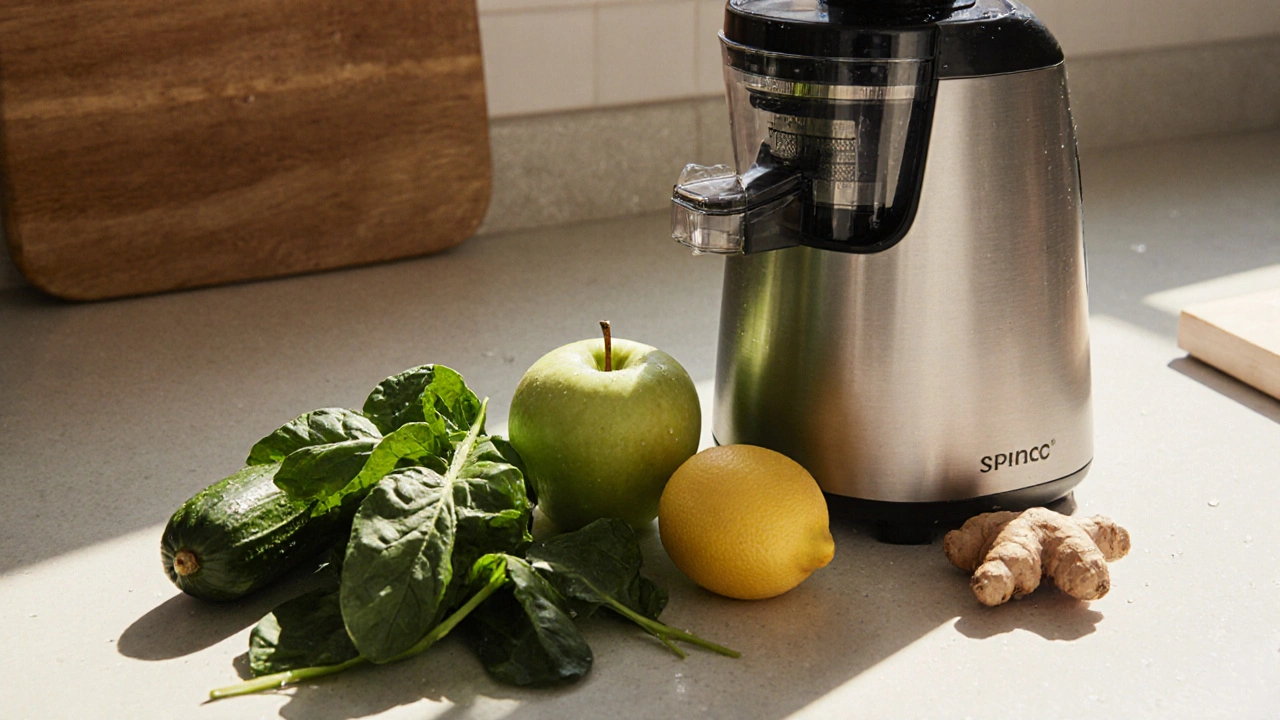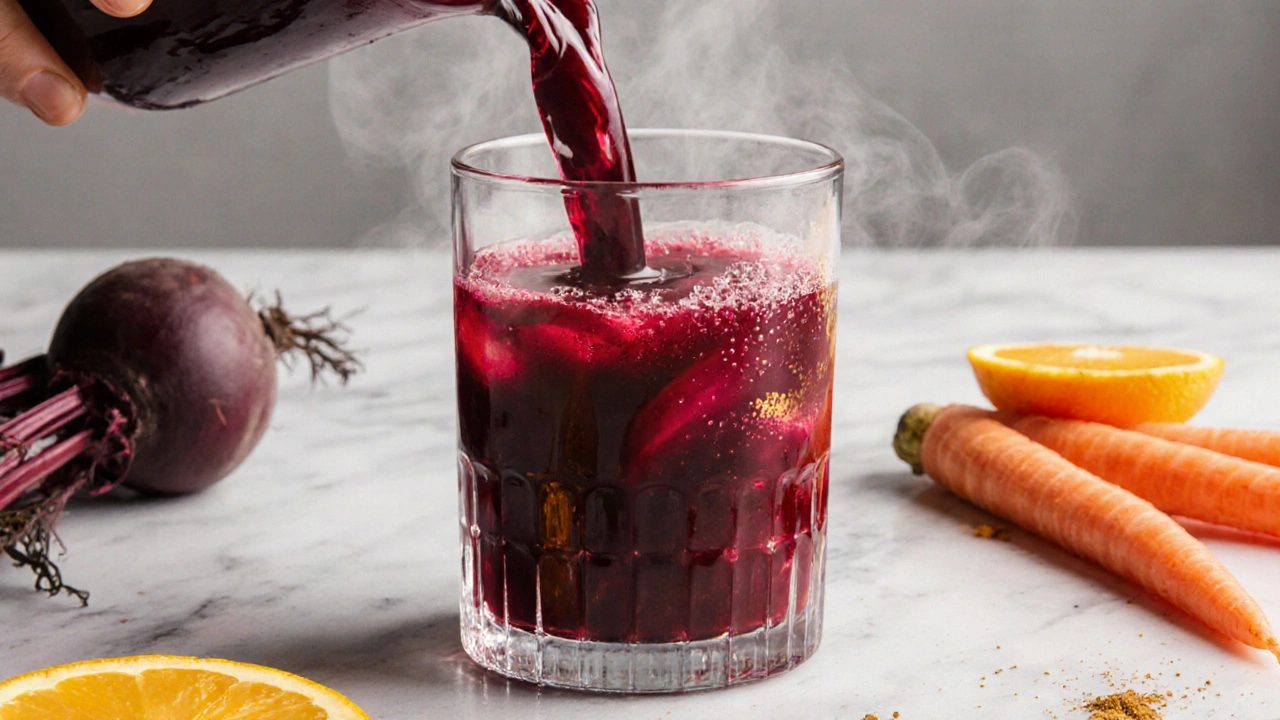
Juice Nutrition Calculator
Customize Your Juice
Calculate sugar content and nutritional balance based on your recipe
Nutrition Analysis
Healthy BalanceSugar Content:
Nutrient Density:
Recipe Ratio: 35% fruit / 65% vegetables
This follows the article's recommended 60/40 vegetable-to-fruit ratio.
Total fruit servings: 1.5
Total vegetable servings: 2.5
Recommended: 1-2 fruit servings per batch
✅ Balanced for daily consumption
Drinking juice isn’t just a trend-it’s a simple, powerful way to pack more vitamins, minerals, and antioxidants into your day. But not all juices are created equal. Store-bought versions often load up on sugar, preservatives, and empty calories. The real magic happens when you make your own using fresh fruits, vegetables, and a few smart additions. If you want to stay fit and healthy without spending hours in the kitchen, these juice recipes deliver real results-no gimmicks, no hype.
Why Juice Matters for Your Health
Most people don’t eat enough vegetables. The CDC says fewer than 1 in 10 adults get the recommended daily amount. That’s where juice steps in. When you blend leafy greens, carrots, beets, and apples, you’re not just drinking flavor-you’re giving your body a concentrated dose of nutrients your cells need to repair, fight inflammation, and keep energy levels steady.
Unlike smoothies, juices remove the fiber, which means your body absorbs nutrients faster. That’s helpful if you’re recovering from illness, dealing with digestive issues, or just need a quick boost before a workout. But don’t confuse fast absorption with a magic fix. Juicing works best as a daily habit, not a detox fad. Think of it like taking a multivitamin-but with taste, color, and real food.
The Rules for Making Healthy Juice
Not every juice recipe is good for you. Here’s what actually matters:
- Keep sugar low. Fruit has natural sugar, but too much spikes blood glucose. Stick to 1-2 servings of fruit per batch and fill the rest with veggies.
- Use dark greens. Spinach, kale, and Swiss chard are mild in flavor and packed with iron, calcium, and vitamin K.
- Add ginger or turmeric. These aren’t just for flavor-they reduce inflammation and help digestion.
- Drink it fresh. Nutrients start breaking down within 20 minutes of juicing. Make it right before you drink it.
- Don’t skip the veggies. Carrots, cucumbers, celery, and beets add sweetness naturally without the sugar crash.
Forget the 80/20 rule (80% veggies, 20% fruit). In practice, that’s too strict for most people. Start with 60/40. If you’re new to greens, you’ll thank yourself later.
5 Juice Recipes That Actually Work
1. Green Energy Booster
This one’s a daily staple for people who need steady energy without caffeine.
- 2 cups spinach
- 1 cucumber
- 1 green apple
- 1/2 lemon (peeled)
- 1-inch piece of ginger
- 1/2 cup coconut water (optional, for electrolytes)
Blend until smooth. Taste? Crisp, slightly sweet, with a kick of ginger that wakes you up. Perfect for mornings. I make this every day during Calgary’s winter months-it’s the closest thing I’ve found to a natural energy pill.
2. Beetroot Glow
Beets are nature’s blood purifiers. They help lower blood pressure and improve circulation. This juice gives you a natural flush-not from alcohol, but from nitric oxide.
- 1 medium beet (peeled)
- 2 carrots
- 1 apple
- 1/2 inch turmeric root (or 1/4 tsp powder)
- 1/4 cup orange juice (freshly squeezed)
- Pinch of black pepper (boosts turmeric absorption)
It’s earthy, sweet, and bright red. You’ll feel it in your skin and your stamina. I’ve had clients with chronic fatigue say this changed their mornings. Don’t be afraid of the color-it stains everything, but it’s worth it.
3. Citrus Detox
Not a “detox” in the scammy sense. Just a clean, refreshing way to support liver function and hydration.
- 2 oranges (peeled)
- 1 grapefruit (peeled)
- 1 celery stalk
- 1/2 lemon (peeled)
- 1/2 inch ginger
- 1/4 cup filtered water (to thin if needed)
This is the one I reach for after a heavy meal or a night out. It’s tart, zesty, and doesn’t leave you feeling bloated. The celery adds a subtle saltiness that balances the citrus perfectly.
4. Carrot Ginger Immunity
Winter is here. Your immune system needs all the help it can get.
- 4 large carrots
- 1 apple
- 1-inch ginger
- 1/2 tsp cinnamon
- 1/4 cup pineapple (fresh, not canned)
Pineapple adds bromelain, an enzyme that reduces swelling and supports digestion. The cinnamon helps stabilize blood sugar. This juice tastes like dessert-but it’s doing serious work inside your body. My neighbor, a teacher in her 60s, drinks this every morning. She hasn’t missed a day of work in two winters.
5. Cucumber Mint Cooler
For hot days, post-workout recovery, or when you just need to feel refreshed.
- 2 cucumbers
- 1 green apple
- 10 fresh mint leaves
- 1/2 lime (peeled)
- 1/4 cup water
It’s light, hydrating, and smells like a garden. Mint has natural antispasmodic properties-it can ease bloating and stomach cramps. I keep a jar of this in the fridge for my kids after soccer practice. They think it’s a treat. I know it’s medicine.

What to Avoid
Here’s what most juice blogs get wrong:
- No juice cleanses. Your liver and kidneys already detox you. A 3-day juice fast won’t “reset” your system-it’ll just make you tired and cranky.
- No added sugar. Honey, agave, maple syrup? Skip them. If it’s not sweet enough, add more apple or carrot.
- No juice as a meal replacement. You need protein and fat to stay full and balanced. Use juice as a snack or supplement, not a substitute.
- No storing for days. Even in a sealed jar, juice loses half its nutrients within 24 hours. Make it fresh. Always.
Tools You Actually Need
You don’t need a $500 juicer. A decent centrifugal juicer under $100 works fine. If you want to preserve more nutrients, go for a masticating (cold press) model. But honestly? The best juicer is the one you use.
Wash your produce well. Peel citrus and ginger. Cut everything into pieces that fit your juicer. Clean it right after use-dried pulp is a nightmare to scrub.
And here’s a pro tip: freeze citrus peels in small batches. When you’re juicing, add a piece of frozen peel for extra flavor and antioxidants. No waste.

How to Make It Stick
Most people start strong and quit by week two. Here’s how to keep going:
- Prep the night before. Wash and chop your veggies. Store them in clear containers in the fridge. In the morning, it’s 30 seconds of work.
- Pair it with something. Drink your juice with a boiled egg, a handful of nuts, or a slice of whole grain toast. It makes you feel satisfied.
- Track how you feel. After a week, notice your energy, skin, digestion. Those are your real metrics-not weight loss.
- Invite someone. Juice with a friend. Text each other photos. It’s harder to quit when someone else is doing it too.
I started juicing because I was tired all the time. Three months in, I stopped needing my afternoon coffee. Not because I’m a superhuman. Just because my body finally got the nutrients it was begging for.
When to Skip Juice
There are times when juice isn’t right:
- If you have diabetes, monitor your blood sugar. Even natural sugars can spike levels. Talk to your doctor.
- If you’re on blood thinners, avoid large amounts of kale or spinach. They’re high in vitamin K, which affects clotting.
- If you have kidney disease, limit beets, spinach, and Swiss chard-they’re high in oxalates.
Listen to your body. If a juice makes you feel worse, stop. There are plenty of other options.
Can I drink juice every day?
Yes, if you keep it balanced. Stick to mostly vegetables, limit fruit to one serving per juice, and drink it fresh. Daily juicing can support your nutrient intake, but it shouldn’t replace whole foods or meals.
Does juice help with weight loss?
Not directly. Juice isn’t a magic weight-loss tool. But replacing sugary drinks with low-sugar, veggie-based juice can cut hundreds of calories a day. Combine that with regular movement and balanced meals, and you’ll see results over time.
What’s the best time to drink juice?
Morning on an empty stomach is ideal-it lets your body absorb nutrients quickly. But afternoon or post-workout works too. The key is consistency, not timing.
Can I use frozen fruits and veggies?
Yes, but fresh is better. Frozen produce is often blanched before freezing, which reduces some enzymes and nutrients. Still, it’s better than nothing. Just thaw it first and avoid juices with added syrups or sugars.
Do I need to buy organic?
Not always. Focus on the Dirty Dozen list-produce with the most pesticide residue (like strawberries, spinach, apples). For thicker-skinned items like bananas or avocados, conventional is fine. Wash everything under running water before juicing.
Final Thought
You don’t need to be perfect. Miss a day? No problem. Make a batch on Sunday and drink it through the week. Add a splash of lemon to water if you’re short on time. The goal isn’t to drink five juices a day-it’s to make healthy choices easy, enjoyable, and sustainable. Your body doesn’t need miracles. It just needs consistent care. Start with one glass. See how you feel. Then make another.





